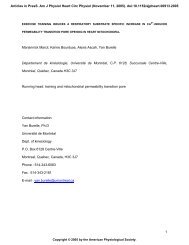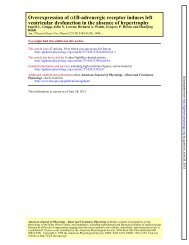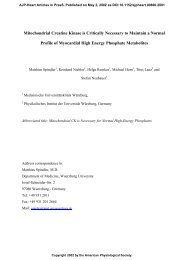The role of eNOS, iNOS and NFκB in upregulation and activation of ...
The role of eNOS, iNOS and NFκB in upregulation and activation of ...
The role of eNOS, iNOS and NFκB in upregulation and activation of ...
You also want an ePaper? Increase the reach of your titles
YUMPU automatically turns print PDFs into web optimized ePapers that Google loves.
Ye Y, et al. Mechanisms <strong>of</strong> COX2 <strong>upregulation</strong> by atorvastat<strong>in</strong> 10<br />
PBS. <strong>The</strong> Alexa-secondary antibodies [Goat anti-mouse IgG with Alexa 488 (488-GAM)<br />
for monoclonal primary antibodies (Molecular Probe, A-11029), <strong>and</strong> goat anti-rabbit IgG<br />
with Alexa 594 (594-GAR) for rabbit polyclonal primary antibodies (Molecular Probe,<br />
A-11037)] were centrifuged at 12,000 rpm at 4 0 C for 2 m<strong>in</strong>, diluted 1:200-1:400 <strong>in</strong> PBS.<br />
<strong>The</strong> sections were <strong>in</strong>cubated with the Alexa-secondary antibodies <strong>in</strong> dark at room<br />
temperature for 1h, washed <strong>in</strong> PBS for 3 times, <strong>in</strong>cubated <strong>in</strong> 1µg/ml DAPI (1:1000<br />
dilution) at room temperature for 5 m<strong>in</strong> <strong>in</strong> the dark, <strong>and</strong> r<strong>in</strong>sed with PBS. <strong>The</strong> sections<br />
were dried, <strong>and</strong> Fluoromount-G was added onto the slides, <strong>and</strong> the slides were covered<br />
with a cover-slip. Slices were stored at 4 0 C, until exam<strong>in</strong>ed <strong>and</strong> photographed under<br />
microscope.<br />
Biot<strong>in</strong> switch assay<br />
S-nitrosylation <strong>of</strong> COX2 was determ<strong>in</strong>ed with the biot<strong>in</strong> switch method, as has been<br />
previously described [2]. Myocardial samples were homogenized with HEN buffer [25<br />
mM HEPES (pH 7.7)-0.1 mM EDTA-0.01 mM necupro<strong>in</strong>e]. <strong>The</strong> supernatant conta<strong>in</strong><strong>in</strong>g<br />
membrane fragments <strong>and</strong> the cytosolic prote<strong>in</strong> was recovered. <strong>The</strong> samples were<br />
<strong>in</strong>cubated for 30 m<strong>in</strong> at 4°C with block<strong>in</strong>g solution conta<strong>in</strong><strong>in</strong>g HEN buffer, 0.1% SDS,<br />
<strong>and</strong> 20 mM N-ethylmaleimide [NEM] to block free thiols. Lysates were centrifuged at<br />
16,000 Xg for 10 m<strong>in</strong> at 4°C. Cold acetone was added to precipitate the prote<strong>in</strong>s. <strong>The</strong><br />
pellets were resuspended <strong>in</strong> HEN buffer with 1% SDS, with 20 mM sodium ascorbate<br />
added to decompose the SNO bonds. <strong>The</strong> result<strong>in</strong>g free thiols <strong>in</strong> the sample were reacted<br />
with 0.05 mM biot<strong>in</strong>ylat<strong>in</strong>g agent, biocyt<strong>in</strong> [MPB] for 30 m<strong>in</strong> at room temperature. <strong>The</strong><br />
excess MPB was removed by additional prote<strong>in</strong> precipitation <strong>in</strong> cold acetone. COX2 was<br />
immunoprecipitated with anti-COX2 polyclonal antibody. Immunoprecipitates were<br />
Copyright Information<br />
Page 10 <strong>of</strong> 35






